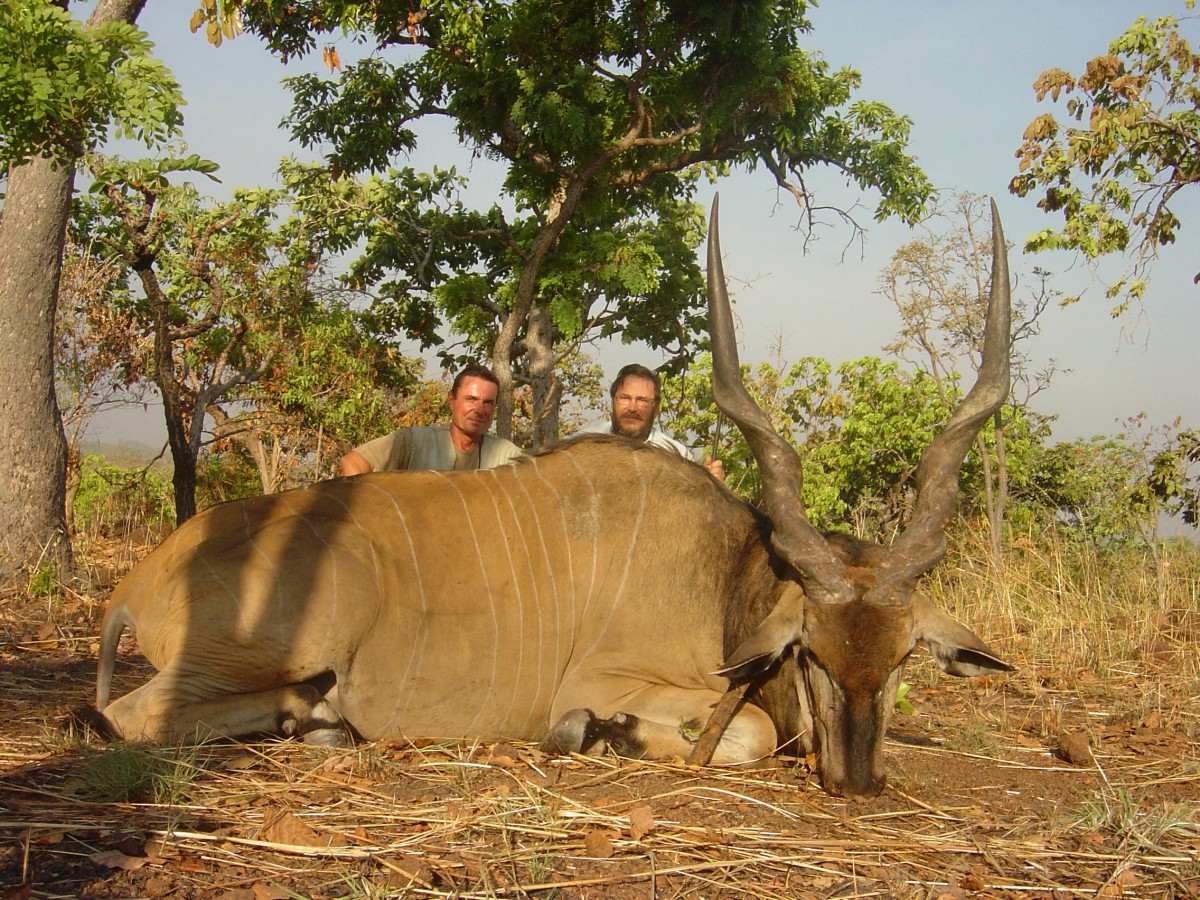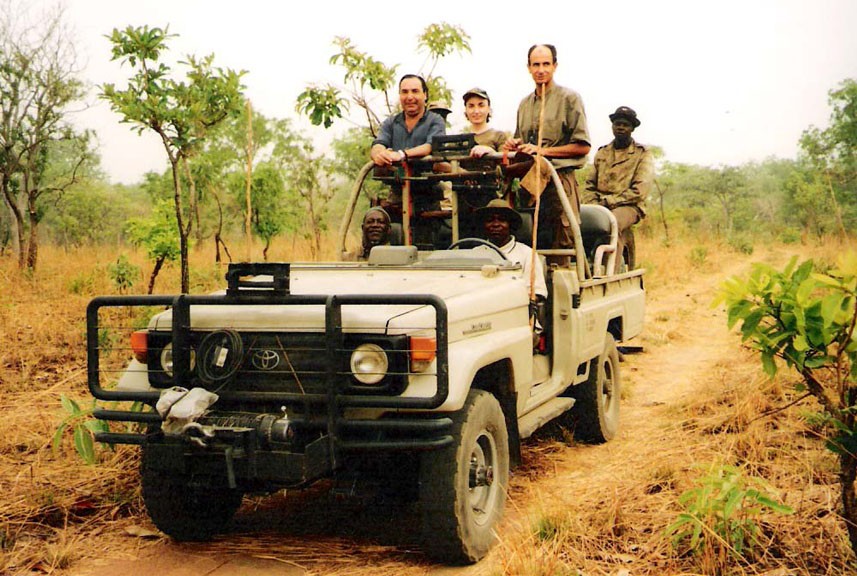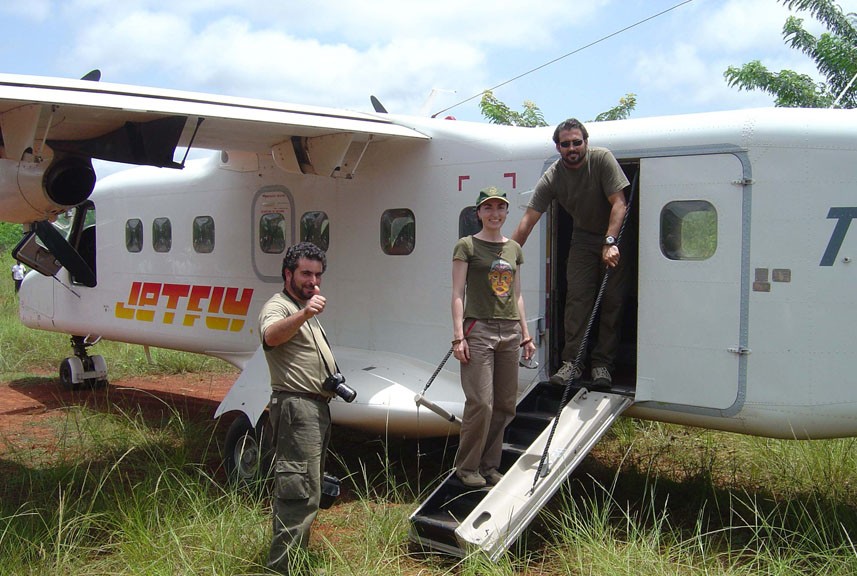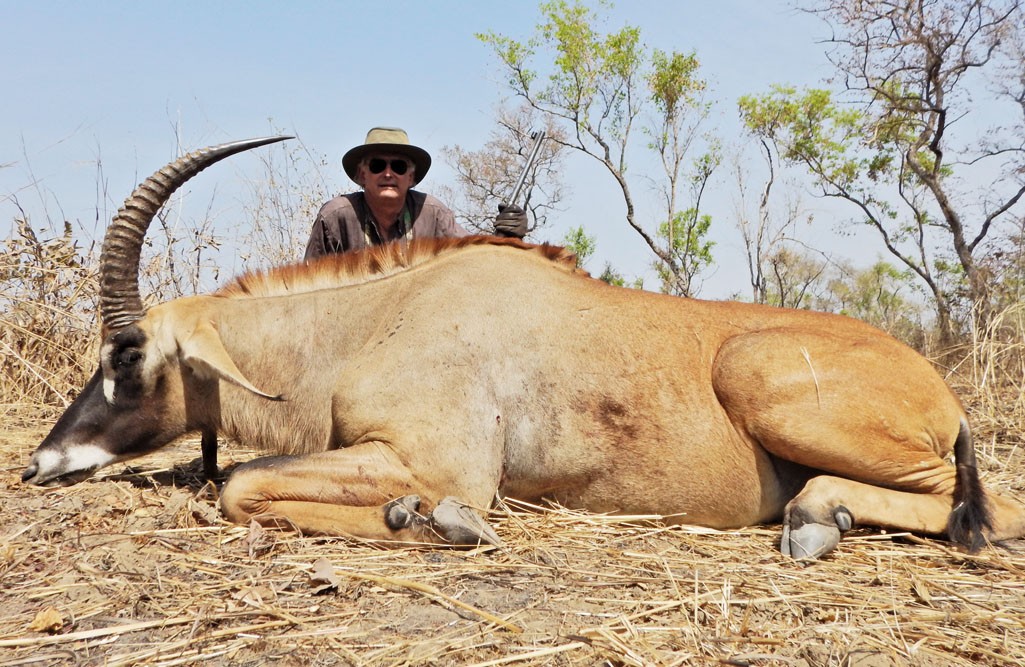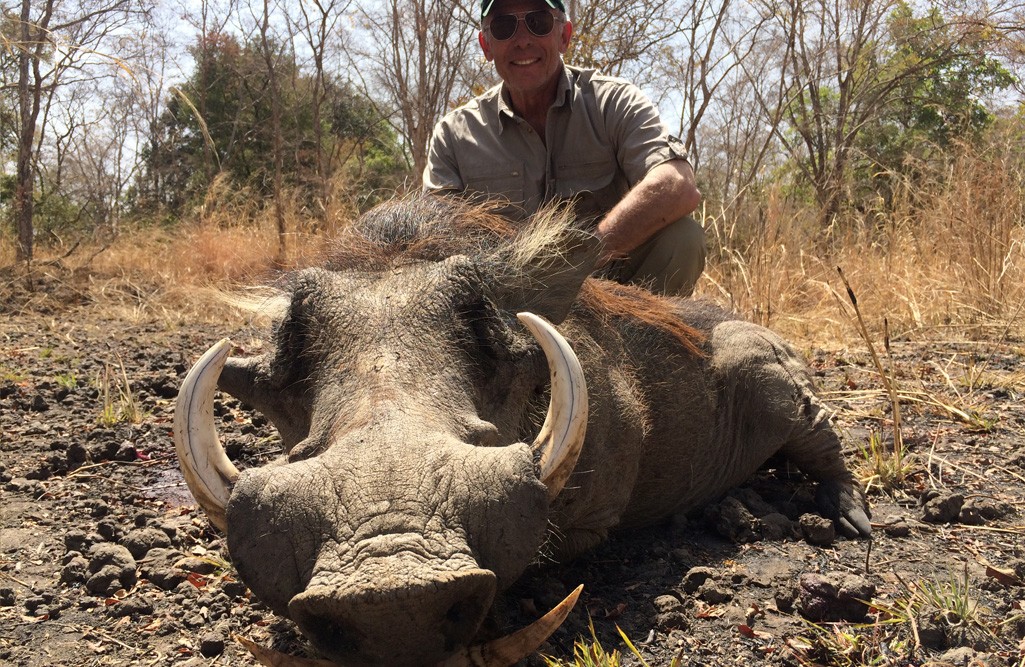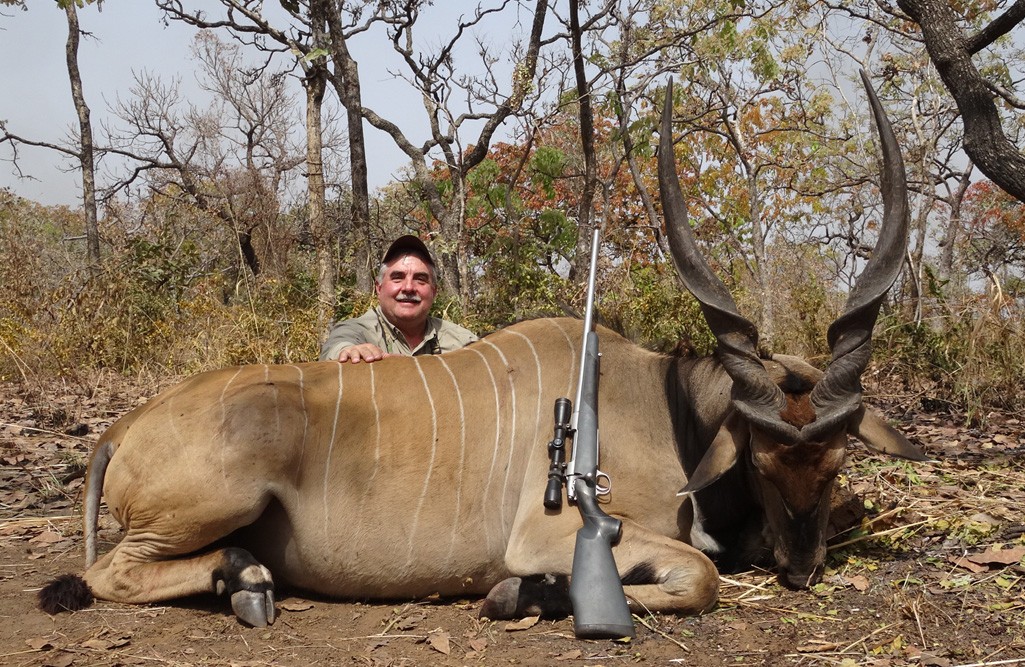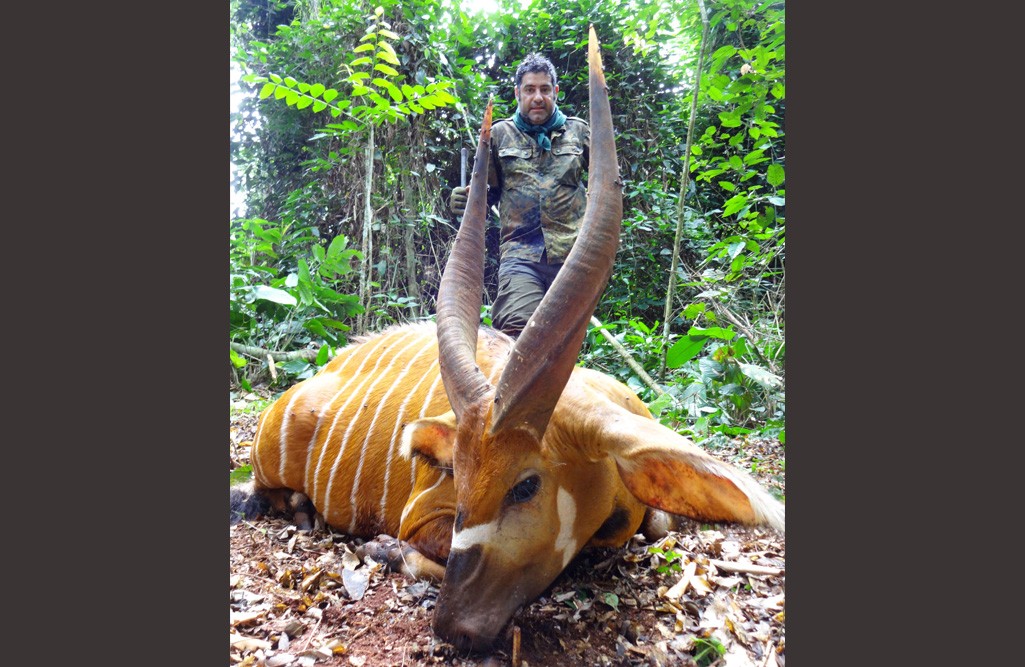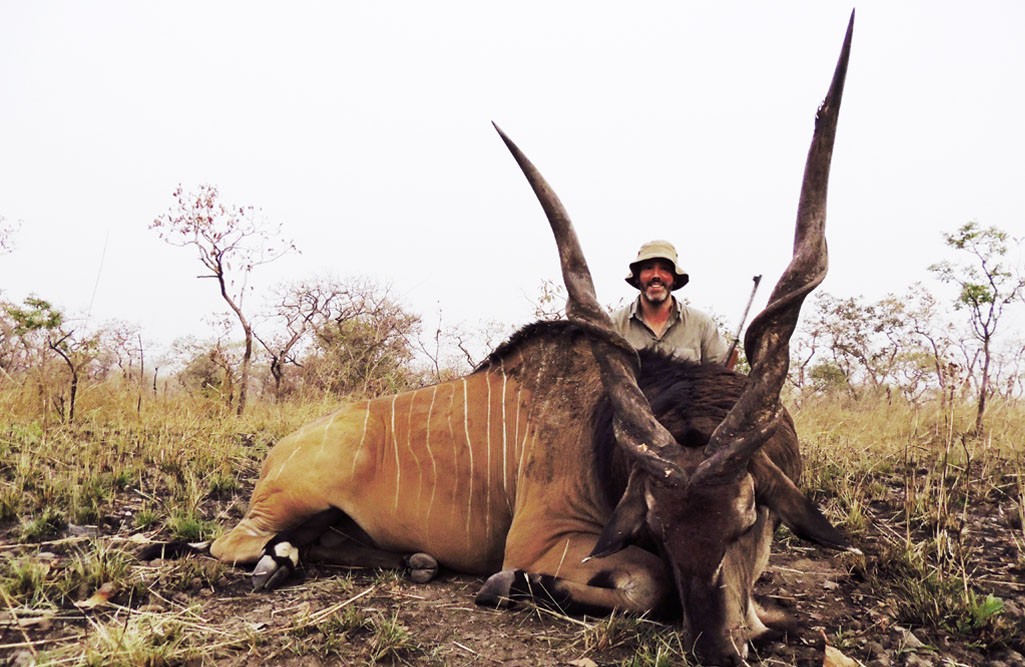This outfitter has become one of, if not THE most respected outfits in Cameroon. Craig Boddington, perhaps today’s leading expert on Africa, said this about his two safaris with this outfit:
“I have hunted in Africa something like 50 times, and you have one of the best outfits I have ever seen!”
Jim Shockey and Peter Flack have also hunted with this outfitter. Another name of fame, none other than Warren Parker, after two safaris with this outfit, announced that he was going to write the hunt up and publish it in the SCI magazine, he was so pleased. This from a guy with nearly 400 species to his credit! Now folks, these guys have been most everywhere, have done most everything, and they each made the choice to hunt with this outfitter!!
Legendary success, quality PHs, great hunting areas, and species including the bongo, the sitatunga, the giant Lord Derby eland, western Roan, dwarf and Northwestern buffalo, many of the rarer duikers – this is a great place to hunt. We are proud to be associated with them and we are confident you cannot find a better hunt in Cameroon!
This outfitter has two types of African hunts, so you can choose to hunt either forest or savannah – or both!
SAVANNAH HUNTS
Their first savannah camp is located between two National Parks, Boubanjida and La Benoue. Species here include the unique North Cameroon Derby eland and the amazing giant topi. You may see a herd of elephants, Western roan, Northwestern buffaloes, hippos and even lions. No one has been more successful on Lord Derby eland!
They have a total of four savannah camps, all offering spectacular hunts for different species. With all these various savannah camps, they operate with nearly double the number of licenses over any other company. We suggest that any savannah safari take place during the dry season, meaning, from Christmas to the end of May. Now let’s look at their forest hunts for bongo, etc.
FOREST HUNTS
This outfitter in 2000 was able to acquire from the Cameroon Government the virgin forest area called “The Boumba”, noted for its large number of bongo and for its high quality trophies, including the unique forest elephant. Importantly, from our view, this forest area accounts for approximately 40% of the total licenses granted by the Cameroon Government to hunt dwarf buffalo and forest sitatunga! Because this area has been such an isolated and remote area, often requiring a dugout boat to go through, there is an abundant diversity of animals. Therefore, you can find all kinds of duikers, Bates pygmy antelope, bush pig and, with a little bit of luck, even the giant forest hog. In 2002 they acquired another forest area called “Lognia”, located on the border of Cameroon with the Congo and C.A.R. and protected by the Lobeke National Park. This is a classic bongo hunting area consisting of forest crossed by old travel routes. They now have 4 forest hunting areas in all.
In our opinion, for a forest safari, best times are starting in mid-March and going on until late July. During these months, a three-hour daily rain wets the ground, allowing hunters to follow tracks quietly by avoiding dry leaves. Although it normally rains at night, you can expect rain anytime.
BONGO TROPHIES
2024 PRICING: (all prices in USD unless otherwise indicated and are subject to change without notice)
SAVANNAH
Hunting is on a 1 x 1 basis. Each PH has his own vehicle and a team of trackers and porters. All safaris are scheduled with one to a maximum three hunters per camp.
On 15-day safaris, days 1 and 15 are transfer days. This means there are 13 full days of hunting, with some possible hunting on arrival and departure days, depending on domestic flights schedules.
15-day Lord Derby eland safari at Djibao camp $47,000
15-day Lord Derby eland safari at other camps $37,000
15-day Big safari any species except eland at any camp $20,000
8-Day Medium safari for animals in groups B and C $9,000
(Medium license included, but not Special)
Prices include:
– Airport assistance upon arrival and departure;
– Professional hunter with trackers and porters;
– Full board and soft drinks while in camp: beer and wine in reasonable quantities with meals;
– Support crew: cook, skinner, waiter, laundry service, driver, mechanic, etc.;
– Fully-equipped, permanent camp with stone-built bungalows and en-suite bathroom, lounge/dining area;
– Use of additional semi-permanent fly-camp;
– Preparation of trophies for shipment;
– Unlimited use of hunting vehicles while on safari.
Not included:
– Observers at $300 per day;
– Big hunting license for 1,650 €;
– Trophy fees on animals taken or wounded (*);
– Pre-taxidermy, packing & wrapping, transport to Douala, storage until the shipping agent takes care of the trophies:
o Animals included in one Big license: 975 €
o Medium license only: 600 €
o Big and medium license: 1,250 €
o Full skins of animals from group A: 100€ each (except for elephant parts or full skin, which will be more costly, depending on the individual case)
– Intercontinental flights;
– Charter flights Douala-camp round trip, or domestic flights;
– Possible renting of rifles and ammunition;
– Personal expenses of any sort: hotel charges before and after the safari, possible use of satellite telephones, possible extra trips for picking up delayed luggage/rifles;
– Gratuities;
– Any kind of insurance.
The Big hunting licence allows for taking two different species from group A and four from group B or C, but none from Special category. The Special category license allows for waterbuck, bushbuck and another four animals from B or C. The Medium hunting licence allows for six different species from group B or C (but none from A). It is illegal to double the same species, irrespective of the license held.
For Big safaris (15 days) it is possible to upgrade with an additional medium licence or special category license in order to hunt six additional animals from groups B or C (without repeating any) by paying an extra of 2,500 € (hunting licence cost included, but not the trophy fees).
Available species and trophy fees in EUROS (*):
Group A:
Giant Eland 3500
Northwestern Buffalo 1800
Western Roan 2000
Special Category
Harnessed Bushbuck 500
Sing-sing waterbuck 900
Group B
Western Hartebeest 800
Nigerian Bohor Reedbuck 450
Western Cob 400
Warghog 400
Group C
Western Bush Duiker 300
Red-flanked Duiker 375
Oribi 300
Babbon 200
Python 325
Civet Cat 250
(*) Anti-poaching and community-development program: in order to support an effective year-round anti-poaching campaign, as well as for advocating the value of wildlife to the villagers adjacent to and within hunting blocks, a fee of 10% of the above trophy fees will be collected to fund these programs under outfitter’s direct supervision. They have implemented these programs in all their hunting areas and have found that the results of direct funding for these necessary actions have been extremely beneficial in the overall quality of the hunting experience offered to clients. These fees are paid at the conclusion of the safari, based on the final trophy fee amounts.
Note: Government fees might be modified (increased) without prior notice. The outfitter cannot be held responsible for any such modification.
FOREST PRICING 2024
Hunting on a 1 x 1 basis. Each professional hunter has his own vehicle and a team of trackers and porters. All safaris are scheduled with a maximum of two hunters per camp at the same time.
On 16-day safaris, days 1 and 16 are transfer days. This means there are 14 full days of hunting, with some possible hunting on arrival and departure days.
16-day bongo AND sitatunga safari at Boumba camp $45,000
16-day bongo OR sitatunga safari (with buffalo or elephant) at any other camp $35,000
16-day bongo AND sitatunga safari at other camps $40,000
Prices include:
– Airport assistance upon arrival and departure;
– Professional hunter with trackers and porters;
– Full board and soft drinks while in camp: beer and wine in reasonable quantities with meals;
– Support crew: cook, skinner, waiter, laundry service, driver, mechanic, etc.;
– Fully-equipped, permanent camp with stone-built bungalows and en-suite bathroom, lounge/dining area;
– Use of additional semi-permanent fly-camp;
– Preparation of trophies for shipment;
– Unlimited use of hunting vehicles while on safari.
Not included:
– Observers at $300 per day;
– Big hunting license for 1,650 €;
– Trophy fees on animals taken or wounded (*);
– Pre-taxidermy, packing & wrapping, transport to Douala, storage until the shipping agent takes care of the trophies:
o Animals included in one Big license: 975 €
o Medium license only: 600 €
o Big and medium license: 1,250 €
o Full skins of animals from group A: 100€ each (except for elephant parts or full skin, which will be more costly, depending on the individual case)
– Intercontinental flights;
– Charter flights Douala-camp round trip, or domestic flights;
– Possible renting of rifles and ammunition;
– Personal expenses of any sort: hotel charges before and after the safari, possible use of satellite telephones, possible extra trips for picking up delayed luggage/rifles;
– Gratuities;
– Any kind of insurance.
Big hunting licence allows for taking of two different species from group A and four from group B or C. Small hunting licence allows for all species from group C (but none from A and B). It is illegal to double the same species, irrespective of the licence held.
GETTING THERE TO CAMEROON
Daily flights from Paris to Douala. Two flights per week from Brussels to Douala/Yaounde or from Paris to Yaounde. Once in Cameroon, you have the following possibilities to get to your final destination.
TO SAVANNAH CAMPS
Domestic flight from Douala/Yaounde to Garoua or Ngaoundere, a city about 230 Km from the camps, which means four hours’ driving trip. Approx. fare: €350 round trip.
TO FOREST CAMPS
Charter flight from Douala to Lokomo. Fare depends on the number of passenger sharing the flight and the cost can be 4,000€ per person r/t. Or, about two days’ driving from Douala (but better Yaounde) to camp. Fare: €2,500 round trip. (NOTE: THIS DRIVE IS NOT RECOMMENDED).
TO COMBINED SAFARIS
Either charter a flight from Garoua to Lokomo or Kika for €15,000, or take a domestic flight from savannah camp, stay overnight at Douala and take a shared charter to forest camp.
A host person will always assist clients on their arrivals/departures to any of the Cameroon airports (Douala, Yaounde, Garoua, Ngaoundere, Bertoua, Moloundou or Kika).
If needed, domestics and charters flights can be reserved through the outfitter, but you should give at least thirty days’ advance notice. No responsibility if taken for any flight cancellations or charter fare changes.
Charter flight costs could be share with other hunters in order to reduce the cost, and the outfitter will attempt to coordinate arrival/departure dates and times to coincide with other hunters. But no promises on that. Some people like the overland route as they really get to see the country, plus it is much more economical.
NOTE:
If, like most, you have never hunted equatorial Africa, there is much to learn and even more to understand. The experience is as unique as a Polar ice hunt via dog sled for polar bear, but a heck of a lot warmer! The article below is one of the best I have read, and it will give you great insight into this remote and seldom-seen area. You are about to embark on a great adventure, so read this article many times to prepare yourself as best you can. Then go and enjoy it! Our thanks to Cameron Hopkins for his deft storytelling. He hunted with this same outfitter we like so much.
TARZAN’S AFRICA
LIVING A BOYHOOD DREAM OF AFRICA INSPIRED BY JOHNNY WEISSMULLER, THE AUTHOR HUNTS THE AFRICAN FOREST WITH PYGMYTRACKERS
Story by Cameron Hopkins
Wild Hunting magazine, September 2006
Fresh out of a cool shower, I felt the first trickle of sweat crawl across my scalp less than five minutes after the refreshing river water sprayed over me from a gravity-fed tub suspended overhead. Toweling off back in my palm-frond-and-wood hut, I felt the mugginess in the air as a troop of monkeys tittered to each other in a nearby tree.
The temperature was mild, about 75 degrees, but the humidity was as high as a Turkish sauna. All it took to start perspiring again after that cool shower was a little bit of exertion tying my shoes.
I was in equatorial Africa, deep in the rain forests of Cameroon, a scant 20 kilometers from the border of the Congo. I was a visitor, a Tall, in the land of the Bake pygmies (pronounced Baa-kaa), the forest-dwelling natives that have lived much as they live now for the past 10,000 years. The Bake are hunters, phenomenally gifted and patient hunters, and they would show me their ways of finding game amid the thick tropical vegetation, towering trees and dense foliage of the rain forest.
The pervasive hot-towel humidity really wasn’t entirely unpleasant, not when you’re living a boyhood fantasy. I grew up in the ’60s longing for Saturday morning television and my favorite program, Tarzan. The best by far were the Johnny Weissmuller renditions of Edgar Rice Burroughs’s adventure hero, complete with Jane, Cheetah and Boy, and a supporting cast of greedy bad guys and restless natives to fight, not to mention the occasional crocodile to thrash. The chattering of monkeys, honking of elephants, roaring of lions-Africa! Tangled vines, hissing snakes, malarial swamps-Africa! Pygmies, bongos, gorillas, natives-no-go-further-Africa!
My golden dream of Africa, as Roosevelt called it, was to hunt the steamy tropical jungle where Tarzan lived, but I learned as I grew up and read the classics-Roark, Hemingway, Capstick-that the Dark Continent is really not like my boyhood Saturday mornings. Instead of thick, green, tropical rain forests, it was mostly dry, gray savannah dotted with flat-topped acacia, thorn-covered bushes and semi-desert expanses. Instead of hacking our way through a matted tangle of vines in a steamy, green jungle, the Africa I found was mostly an open plain with lots of game, hence the term “plains game.” The hunts took place out of well-equipped, modern safari camps easily reached from a major metropolis with an international airport, like Johannesburg.
I was mildly disappointed with this Africa. Don’t get me wrong, hunting southern Africa is magnificent, every bit the soul-captivating experience that African hunters say it is. To stalk gemsbok across the red sands of the Kalahari or track Cape buffalo through the jess of the Zambezi Valley are exciting and enthralling and I’ll never forget killing my first kudu along the Timbavati River…but where was Cheetah? This wasn’t the Africa that had sparked the imagination of a young boy. How can it be Africa if it’s not a jungle? I vowed one day to hunt my boyhood Africa, Tarzan’s Africa, and now at last, here I was sweating after a shower in a remote jungle camp in Africa, complete with pygmy trackers, wild forest elephant and, yes, even a pet chimp.
The country was Cameroon, a former French protectorate on the west coast, just in the crook of the elephant’s ear of the continent. I was hunting out of a camp called Lognia, named for a nearby stream, that is around two degrees north latitude, less than 120 miles from the earth’s median. It doesn’t get any more equatorial than that. We were less than 20 kilometers away from the Sangwa River, the border of the Congo, truly the fabled jungles of the apeman.
I came to hunt bongo, an exotic orange antelope that lives only in the dense rain forests of equatorial Africa. If I was lucky, my Cameroonian big game license also would allow me to try for some of the other unique species of the forest, animals like the forest sitatunga, yellow-backed duiker, giant forest hog and dwarf buffalo. My license also entitled me to an assortment of little antelopes like the blue and Peter’s duiker or Bate’s pygmy antelope, a tiny little thing not much bigger than a Chihuahua. But the real object was to hunt the shy and secretive bongo. Bongo is a pygmy word for a 600-pound antelope with a stunning coloration of chestnut orange punctuated with dramatic white stripes. Tragelaphus euryceros is a member of the spiral horned family that includes the kudu, bushbuck and eland. Many hunters say the bongo is the most beautiful and desirable of all African antelopes.
Exotic Experience
Apart from actually living those thrilling Saturday mornings of yesteryear, what really attracted me to hunt bongo was not so much the rarity of this remarkably handsome antelope, but more so the unique hunting experience of tracking with pygmies in the rain forest. It just doesn’t get much more exotic than hunting with pygmy trackers chopping a path through thick jungle with their machetes.
In recent years, Cameroon has emerged as the best place to hunt this short-legged, stoutly built, forest-dwelling antelope. Success rates with the better outfitters-and I was hunting with the very best in the country, is 100 percent for bongo on a two-week safari. I was hunting with a seasoned veteran of a professional hunter, French-born Geoffroy de Gentile, who has hunted central Africa for over 20 years, specializing in forest safaris. He hunted for years in the CAR and then hunted in Cameroon with the legendary Jacques Guin, who is to West African PH lore what Percival or Selby were to East.
Geoffroy personally built the Lognia Camp and delineated the boundaries of what is now defined as Hunting Zone 31 when it was first created by the Cameroonian game department as a hunting block. In the past 10 years in the zone, his clients have taken 53 bongo with an average horn length of 28-inches. I was hoping to be happy hunter number 54.
Welcome To The Jungle
As I discovered when tying my shoes, the rain forest redefines mugginess. You simply can’t stay dry, either from sweat, rain, swamps or mud. I brought two pairs of canvas tennis shoes, one to dry out while I was re-soaking the spare pair. Everyone recommended long sleeve shirts and trousers. For this sort of sauna-like heat, I was naturally thinking along the lines of swimming trunks and a T-shirt.
“Cover every part of your body,” Geoffroy advised. “Wear gloves and a hat. Cover the back of your neck so caterpillars can’t fall down your shirt. You need gaiters over your lower legs to protect from the thorns and keep the jungle ants from crawling up your trouser leg. Leave nothing uncovered!”
I quickly saw the wisdom of Geoffroy’s 20-plus years of experience. You don’t walk in the forest, you slowly push your way through the undergrowth festooned with sharp thorny barbs, pricking, scratching and tearing at you every step of the way. And if the jagged vegetation isn’t enough, there are the biting ants, stinging caterpillars, poisonous spiders and malarial mosquitoes. You wouldn’t last five minutes in shorts and a T-shirt in the rain forest.
Equipment selection is crucial in the forest, not just because of the inhospitable jungle but also because of what lives in it. For a rifle, Geoffroy told me to bring whatever I liked, as long as it could stop an elephant at three paces. At least a .375, preferably a .416, a .458 even better. I chose an old style Ruger 77 in .458 Win. Mag., the kind with a fast and reliable tang-mounted safety. The old Ruger 77 features a big claw extractor, spring ejector and, most importantly, flawless reliability.
For optics, I put my money where my mouth is and mounted what I think is the best close-range, dangerous game scope extant, Trijicon’s 1.25-4X AccuPoint. This lightning-fast scope features an illuminated post reticle with a sharp red triangle at the top of the post. The lit reticle comes from a combination of fiber optics delivering ambient light to the glowing triangle or, in the dark, tritium self-illumination. With no batteries to drain or complicated electronics to corrode in the humidity, the AccuPoint is ideal for these sorts of conditions.
Ammunition is just as critical and for the big .458 Win. Mag., the best loading available is Hornady’s “turbo charged” Heavy Mag carrying the same firm’s heavily reinforced 500 gr. bronze solids. With Hornady’s Heavy Mag, a .458 can honestly reproduce the velocity of the .470 Nitro Express, the cartridge it was designed to duplicate. This magic number is 2,150 feet per second, a benchmark only Hornady’s Heavy Mag achieves of all the factory offerings. So I was set, proper clothes, a big gun, good ammo, a perfect scope and a seasoned professional hunter. All that remained was to meet the rest of the hunting team, the fabled pygmies of the rain forest.
It’s A Short World
Geoffroy de Gentile, who, as the oldest son of the oldest son of the oldest son going back five generations, is actually a French count, shook his head affectionately and smiled paternalistically when I asked him about his pygmy trackers. “The pygmies are the best hunters in Africa. They live in the forest, they know everything about the forest. They find tracks where there are no tracks,” said the 44-year-old PH in his marvelous Marcel Marceau French accent.
“The pygmies believe they live in heaven. Really. Everything they want is in the forest. If they want food, the forest gives them fruit, meat, vegetables. The forest always has fresh water and the rivers have fish. If they are sick, the forest has medicine. They don’t understand why anyone needs anything beyond what the forest gives them.
“The pygmies like to sing-they are a happy, care-free people-and one song starts like this: ‘Deep in the forest, live a little people. Born in the past, living for the future.’ This says a lot about the pygmy.”
We were hunting with pygmies from the Bake tribe, a large clan of semi-nomadic forest dwellers living in Cameroon, the CAR and Congo. They come and go as they please. The pygmies are the only people in the world who can legally cross international boundaries without a passport; they’re defined by international convention as “citizens of the forest.”
Incidentally, the term “pygmy” is not at all derisive or racist. They are proud of being pygmy. They refer to all others as “the Tall,” with not the slightest bit of jealousy or resentment. The pygmies are friendly and hospitable by nature, a part of their open and accepting hunter-gatherer culture.
During my safari, I got to know a pygmy named Monbateau quite well. He was assigned as my gun bearer and a lead tracker, but he was quite happy that I never asked him to carry my rifle. I don’t believe a man should ever allow another man to serve as his beast of burden, simply because it’s not dignified. Besides, I want that big Ruger in my hands when we could encounter an elephant or buffalo unexpectedly.
Monbateau smiled infectiously, his strikingly white teeth straight and beautiful. Unlike many of the Bake tribe, Monbateau didn’t chisel his front teeth into sharpened points. His natural leadership was evident as he hustled and cajoled the other trackers when they weren’t quite as diligent as he liked. Monbateau didn’t know how old he was, but almost certainly less than 30. Pygmies don’t have long life spans, 40 for a woman and 45 for a man.
We hunted with anywhere from four to nine Bake at a time, half of which brought their own hunting dogs. These small, thin mutts resemble a shorthaired coyote in size and conformation, a sort of mixed breed of domestic and wild dog. Fed well, but sleek as greyhounds from hunting every day (and probably a good case of worms), these dogs were to be pivotal in my bongo hunt.
The Orange Ghost
Hunting bongo begins with searching for tracks. We drove the rain-polished, sun-baked dirt trails cut by logging companies to transport the massive saipo and sapelli logs that are hewn from the forest. Without the logging industry, there would be no bongo hunting because there’s no other way to penetrate the dense jungle. As an aside, logging of the African rain forest, at least here in Cameroon, is done responsibly. There is none of this clear-cutting and massive deforestation that you read about in connection with global warming from the destruction of the rain forests. Lumber companies may be bulldozing the rain forest in South America, but not here in central Africa. In fact, each tree is assessed a “trophy fee,” paid by the lumber company, so the cutting is highly selective.
Driving these trails, we looked for three things in a bongo track. First, the track must be fresh. With the frequent rainfall in the forest, the roads are washed clear of tracks with every rain, so finding a fresh track is not as hard as it sounds. Second, the track must be large, belonging to a big male. And lastly, the track must be solitary. If there are two or more sets of tracks, the odds are it’s from a female and a young. We didn’t follow any of those.
Interestingly, the pygmy trackers paid no attention at all to the one thing that is crucial in selecting a track to follow in savannah or bush terrain-wind. The reason is simple. It’s not that bongo can’t smell, it’s that there is no breeze at all under the jungle canopy. The wind swirls above the treetops.
The first track we found was everything we wanted-fresh, big and solo-and so we shrugged into our water-bearing CamelBak daypacks, loaded our rifles, leashed the dogs and set off into the forest.
From the road, the forest appears like a massive green wall of vegetation, but once we plunged inside, we found the foliage varied quite a bit. Big trees towered over us, their leafy branches like giant broccoli overhead, but the undergrowth of broad-leafed plants and dense thorn-covered vines was what blocked our way.
We pushed and clawed into the green thickness, the pygmies swinging their machetes expertly as they chopped a path into the jungle. Parts of the forest are relatively open with not as much undergrowth. This is the primeval forest, Geoffroy explained, forest that is at least 100 years old and has not been cut. The secondary forest, younger with smaller trees and less canopy, lets more sunlight in to feed the undergrowth. It was here that visibility was measured in feet, not yards, and we stepped from one entangling bunch of barbed vines to the next.
The forest floor was covered with a carpet of dead, brown leaves, but we stepped silently across them. The rain keeps the leaves wet and heavy, so there is no crackle or crunch of walking on dry leaves. We inched deeper into the forest and with every track that the pygmies found-a bent branch, a disturbed leaf, fresh droppings-I grew more and more excited.
I marveled at how these amazing little forest people could discern the slightest disturbance on the wet, leafy ground, the subtlest sign of an animal passing. Every now and then the lead tracker would stop and puzzle over the ground. If he wasn’t sure which may the bongo had gone, he would gesture to the sides and the other pygmies would fan out, each bent at the waist, their gentle eyes seeing things I never could.
Loose The Dogs
Suddenly one pygmy gave a short, soft whistle and lifted a leaf to reveal a bongo track. How did he see under the leaf? I was amazed at the uncanny skill. The other trackers honored his find like pointers on a covey of quail. The pygmies picked up the track and plunged into the vegetation, machetes chopping rhythmically. After another half-hour of silent tracking, the lead pygmy froze in midstride and cocked his head to one side. Something moving ahead…
He gestured to the dog handlers and the little dogs sensed the quarry was near. They shivered with excitement as their masters picked up fresh bongo droppings and, crushing the glistening, round droppings in their hands, blew the scent up the nostrils of the dogs. The bongo was close, not more than 20 yards away, and the hunt was on. As the pygmies unclipped their leashes, the dogs dashed ahead silently, noses to forest floor.
Geoffroy had explained the methodology of hunting bongo over dinner our first night in camp. “The pygmy hunt the bongo. They track him, they do the hunting. The job of the dogs is only to hold the bongo once we get close, giving us time to see if it’s a male,” he explained.
“You will only have a moment to decide. You will only see a glimpse of the bongo. The bongo will be fighting the dogs and if he sees us, he will charge. Bongo is very dangerous. We don’t want the bongo to see us, so if we don’t shoot, we leave. Right away! The forest is very thick and we will be very close, five or six meters.
“I will look through my binoculars to see the horns. You must shoot if the bongo sees us and charges. I won’t have my rifle ready when I am looking with the binoculars. If I see it is a good bull, I will tell you and you must shoot quickly-for the shoulder, if you can see it.”
It had not occurred to me that bongo are dangerous, but it makes sense under the circumstances. Geoffroy elaborated, “Any animal, before it charges, must make a decision to fight. Maybe it runs, maybe it fights, it must decide. With the dogs, the bongo has already made the decision to fight. Now, if the bongo sees you, it does not make a decision to charge, it has already made that decision with the dogs. Now it only changes targets. You are more threatening, so it charges.”
And now, suddenly, the dogs were yipping and barking. The lead trackers had run ahead and as we clawed and pushed our way through the barbed vines, one of the pygmies ran back, waving his arms furiously that the bongo was fighting the dogs. Geoffrey plunged ahead into the entangling forest and I followed him into the green wall.
My heart pounded as I heard the dogs barking not more than 10 yards away and, as we shoved our way through the last branches, the sound of the dogs mixed with the thrashing of bushes-the bongo was just six paces away. I was breathing heavily even though the dash through the forest had not been so far, but the excitement was gushing through me.
I saw a blur of orange, a flash of white. “He’s a bull, he’s a bull!” Geoffroy exclaimed. “Shoot, shoot, shoot!”
The big Ruger was already at my shoulder and I looked through the wide view of the Trijicon scope dialed down to its lowest 1.25X setting, virtually no magnification. The bright red aiming triangle shone like a beacon on the chestnut hued bongo. It was close, very close, but the forest was so thick, it was hard to see…
There, the shoulder! I never heard the crash of the elephant rifle as 500 grains of bronze encapsulated Hornady solid bore through both shoulders and the bongo disappeared from the scope. “Good shot, good shot!” Geoffroy yelled. “Come, come!”
We pushed through the last wall of vines and leaves and there was my bongo, a perfectly round, wet, red hole in its shoulder. I kept my rifle at my shoulder, ready to fire if the bongo got up, but it never would. “Watch out for the dogs,” Geoffroy admonished unnecessarily. There would be no need of a finisher.
The pygmies ran up delightedly, cooing and gasping and smiling and strutting around the kill, proud and happy hunters. Suddenly one let out a loud trilling sound and they all erupted with a pygmy cheer. Then the singing started, and the clapping and the handshaking and the hugs. Geoffrey grabbed me by both shoulders and made me look him in the eyes. “There is your bongo!” he shouted as the pygmies skipped and sang. “An old bull, a very old bull! Look at how polished his horns are!”
I looked and I looked again, and the enormity of the moment overwhelmed me. The dogs still barked and licked the bullet wound. The pygmies sang and danced. And I looked up and saw no sky as the jungle canopy shaded the gray mist above us. I silently thanked God for this magical moment, this incredible experience-hunting bongo in the forest with pygmy trackers. Suddenly I was that 12-year-old boy fixed to the black and white TV in our family room. I was here, in Tarzan’s Africa.
Client’s: NOTE!!!!!!!!!!!!!!!!!!!!!!!!!!!!!!!!!!!!!!!!!!!!!!!!!!!!!!!
Ammunition must be separated from weapons and may be packed within checked luggage, but must be properly secured in an ammunition case or solid box. No ammunition may be packed loosely in checked baggage or within the same case as firearms.
All luggage, domestic and international, is now being screened in South African airports. Screeners are finding ammunition in checked bags that is incorrectly packed and are forcing passengers to remove it from their bags, which is causing all kinds of havoc.
All ammunition must now be packed and transported in a lockable ammo box placed within your checked luggage. A manufacturer’s carton is no longer sufficient. Remember that there is also a limit of five kilograms of ammo per passenger. That includes the weight of your ammo box. And don’t forget to declare your ammo at check-in.
We strongly recommend that ammunition be packed in lockable cases, which can be handed in as loose items at the firearm counters to avoid possible delays during checked baggage screening
HONEST ADVICE ON WHO AND WHERE – ASK HUNT-NATION
307-637-5495; info@hunt-nation.com; www.hunt-nation.com

